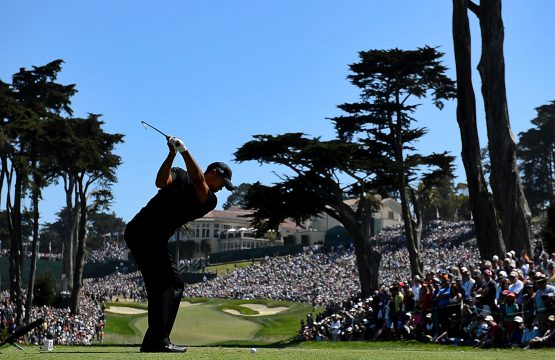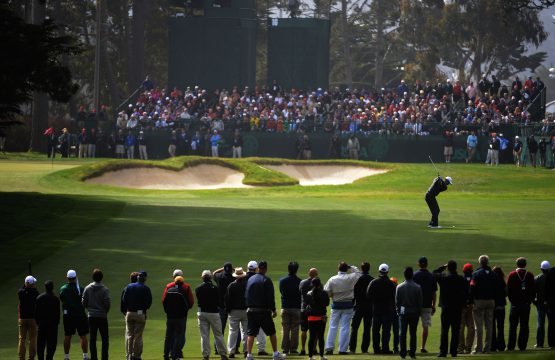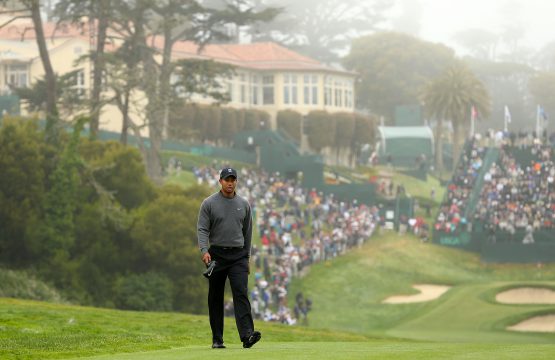Unable to get untracked, Tiger slides with 75
SAN FRANCISCO — Tiger Woods has never won a major championship coming from behind in the final round. On Sunday, he’ll get another chance in the 112th U.S. Open at sun-baked Olympic Club.
Woods, a 14-time major winner, would rather be leading. He was tied for the top spot after two rounds, but struggled to a 5-over-par 75 Saturday. As a result, he’s now tied for 14th at 4-over 214, five strokes behind co-leaders Jim Furyk and Graeme McDowell.
“It was just a tough day all day,” said a frustrated Woods, who made six bogeys and only one birdie.
After leading the field in driving accuracy over the first two days at 75 percent, Tiger hit only seven of 14 fairways on Saturday. He was tied for third in greens in regulation, but found just 11 of 18.
More often than not, Woods left himself with long, tricky putts. As a result, he used 34 in the third round.
“Most of the day, it was amazing,” he said. “I just kept getting that half number just right in between clubs. Just never quite had the right number.”
Woods left the majority of his birdie putts short of the hole.
“They looked quick, and they certainly were much firmer than yesterday,” Tiger said. “But they putted slower. I had a hard time making that adjustment.”
Normally a great scrambler, Woods has had difficulty saving pars, especially from the bunkers. He’s 2-for-9 in sand saves.
Paired with Furyk in the final twosome, and followed by an enormous gallery, Woods didn’t get off to the start he wanted. Dressed in a green shirt and white pants, Tiger hit a 3-wood off the first tee on the 509-yard par-4 and it did not cut, the ball settling into the primary rough on the left. Woods elected to lay up short of the green, leaving 82 yards to the pin, then hit his third shot 12 feet right of the cup and two-putted for a bogey on a hole playing second toughest on the course.
Tiger piped an iron down the fairway at the uphill, 428-yard, par-4 second, and was left with a 162-yard blind second shot. His approach finished 38 feet right of the hole and he two-putted for a par.
At the downhill, 256-yard, par-3 third, Woods came up short-left of the green and was faced with a 50-foot downhill putt. The ball took a big hop on the fringe and wound up nine feet short of the hole. Tiger was unable to convert, missing right, and sustained his second bogey.
Looking to regroup at the 423-yard, dogleg-left, par-4 fourth, Woods split the fairway with an iron, then hit a nice uphill second shot from 167 yards to another blind pin, the ball landing just short of pin-high and releasing 20 feet above the hole. Faced with a slick, downhill line, Tiger two-putted for a par.
Woods drove into the fairway with a long iron at the 498-yard, dogleg-left, par-4 fifth. With 225 yards remaining to the green, he hit a 5-iron into the right bunker. Tiger then hit a nice sand shot three feet short of the back-left pin placement and saved par.
For the third consecutive day, Woods bogeyed the 499-yard, par-4 sixth hole. Once again, he found the fairway with a long iron, but his approach shot from just over 200 yards hopped onto the front of the putting surface, then rolled backward against the collar, leaving a very difficult chip to the back pin position. Tiger ran his third shot about 18 feet past the hole and missed badly on his par attempt.
The first six holes have given most of the players fits all week, but Woods fared well the first two rounds, touring them in 1-under and 1-over. On Saturday, he played them in 3-over.
At the uphill and drivable, 268-yard, par-4 seventh, Tiger drove into the left greenside bunker and had a poor angle to the back-left pin. He did as well as he could with his long sand shot, but the ball released about 19 feet beyond the cup and he two-putted for par.
The seventh hole, a prime birdie hole, has not been kind to Woods thus far the tournament. In three trips, he has made two pars and a bogey.
At the newly designed, 188-yard, par-4 eighth hole, which plays about 60 yards longer than it did in four previous U.S. Opens, Tiger hit a towering 6-iron that flew right over the flagstick but released 25 feet past the hole. Woods called in caddie Joe LaCava to help him read the slick, downhill putt, something he seldom does, and ran his first putt three feet past the hole. In a sign of how his round was going, Tiger lipped out his par putt for his second three-putt of the tournament.
The 449-yard, par-4 ninth hole doglegs to the right, and Woods tried to a cut a driver around the corner. But it didn’t fade and he wound up in the left primary rough. With 128 yards left to the hole, he hit a wonderful punch wedge that nearly hit the pin and rolled 12 feet above the cup. The downhill, left-to-right birdie try but was no bargain, but Tiger hit his best putt of the day, burying the ball into the center of the cup to make the turn in 3-over 37.
Woods hit driver again at the 436-yard, par-4 10th, which slides to the right, and crushed it down the middle of the fairway. With only 118 yards remaining to the back pin, Tiger hit a poor approach that came up 40 feet short of the hole and two-putted for a par.
At the 420-yard, par-4 11th, Woods tried to cut a drive up the fairway but found the primary rough on the left. He had 127 yards to the pin and gouged his second shot just short of the green, fearing a flier. Tiger nearly chipped in for birdie and tapped in for a par.
Woods, still out of sync with his swing, pulled a 3-wood into the left primary rough at the 451-yard, par-4 12th. From 127 yards, he muscled a short iron just short of the green, and it ran up 30 feet right of the left pin placement, the best he could do from his lie and position. Tiger two-putted for a par.
At the 180-yard, par-3 13th, Woods found the green with an 8-iron but came up 35 feet short-right of the left pin. Again struggling with the slowness of the greens, he left the birdie putt nearly four feet short but converted for par.
Tiger hit an iron off the tee at the 429-yard, par-4 14th, which doglegs left up a hill, but the ball scampered into the first cut of the left rough. He had to hook his second shot around trees from 164 yards and hit a great shot, the ball just clearing the right bunker and taking a favorable kick left toward the hole, coming to a rest 17 feet short. The birdie putt never had a chance, and Woods settled for a par.
The tees were moved way up at the par-3 15th, which played only 107 yards. However, the pin was located just over a massive bunker, making it a tricky shot. Tiger’s wedge carried 30 feet past the hole, and he two-putted for a par.
At the 670-yard, par-5 17th, the longest hole in U.S. Open history, Woods blocked his drive into the right trees but got a nice break. The ball finished on hardpan where fans had walked, leaving an opening between huge Monterey Cypress trees.
Tiger hit a low punch that stayed in the fairway, but its placement left 230 yards to the front of the green and required him to hook his third shot around trees. The ball didn’t turn enough and he found the right bunker, short-siding himself. Woods almost hit the pin with his explosion shot, but the ball ran 15 feet past the cup and he two-putted for a bogey.
Woods hit a great drive at the uphill, par-5 17th, but was unable to capitalize. He had 205 yards to the green, changed clubs, then came up well short of the green in a right bunker. He blasted 20 feet below the hole and missed the birdie putt.
At the par-4 18th, Tiger drilled an iron down the fairway and had 137 yards left to the hole. He punched his blind approach shot just right of the green, but instead of kicking left toward the hole, it hung up in the rough. Woods stubbed his third shot 15 feet below the cup and missed the par putt.
So it went. Tiger will try to mount a comeback Sunday when he tees off at 4:50 p.m. ET with Casey Wittenberg.
“I’m definitely still in the ballgame,” Woods said. “I’m only five back, and that’s certainly doable on this golf course, for sure.”


